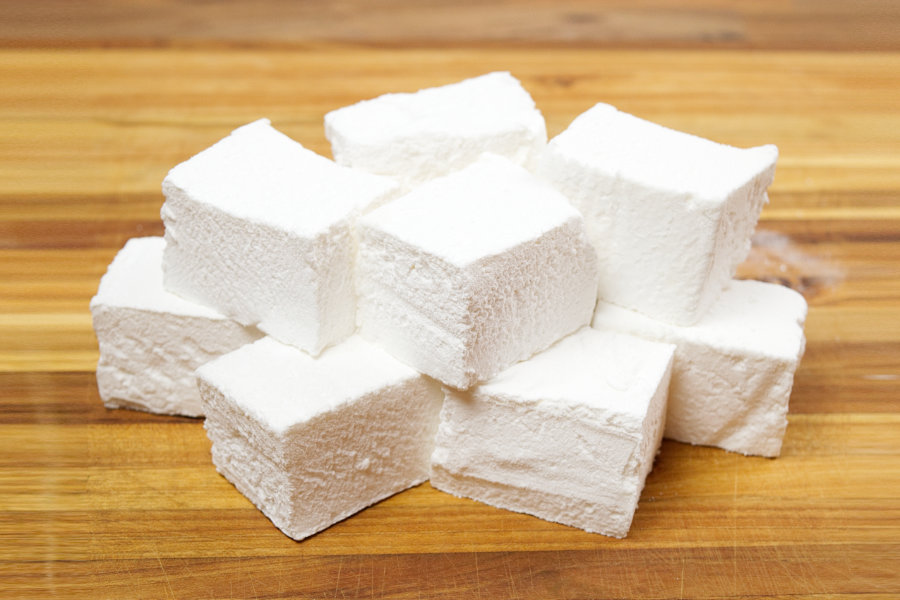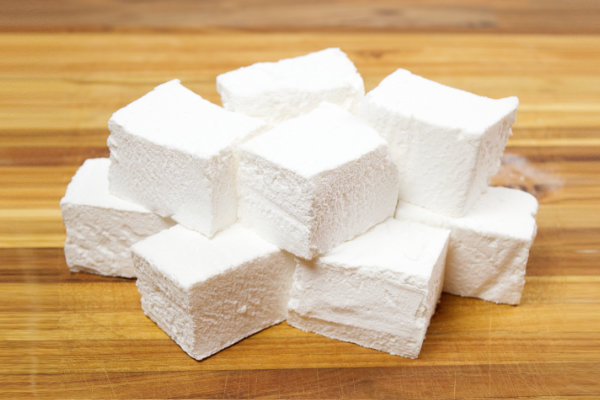





Homemade marshmallows are nothing like the pre-packaged kind, which have an artificial and almost metallic taste. Especially when using real vanilla, marshmallows made from scratch pack a richer decadent flavor. They are extremely easy to perk up with different flavor variations too; just whisk in a tablespoon of extract and your marshmallows will take on a whole new personality.
For an intermediate or advanced baker, this recipe should be a piece of cake. But absolute novices who have never made a meringue before may find the task a bit daunting. This recipe is an Italian meringue-based marshmallow recipe. It begins by preparing an Italian meringue—the trickiest part. Whipping egg whites with very hot sugar forms the base of the marshmallow. Adding hot gelatin will stabilize the mixture as it cools until it becomes a spongy and gelatinous form. Properly stored in an airtight container, these marshmallows should last several weeks.
This recipe is derived from the superb book Patisserie by Christophe Felder, detailing this and hundreds of traditional French recipes.
Makes 2 dozen large marshmallows, or more cut into smaller chunks.









Bloom the gelatin in about 4 tablespoons of cold water. This is an important step to ensure the powder doesn't clump when it's added to the meringue. Cold water will allow the gelatin to slowly hydrate rather than swelling around clumps of dry powder.
Mix the seeds with about two tablespoons of hot liquor or water. Let this vanilla mixture infuse while you move on to other steps. Vanilla beans will add a more pronounced vanilla flavor and scent than dull vanilla extract.
Start preparing the Italian Meringue. These marshmallows are a meringue-based recipe, in which gelatin and an excess of sugar is added to frothy egg whites. Whipping this mixture vigorously for 10 minutes will incorporate a lot of air for ultra fluffy, light, squishy marshmallows.
Preparing the meringue requires you to heat the sugar while the egg whites are whipping. This is why a stand mixer is almost a necessity for this recipe. However a hand beater and some skillful timing will work as well.
When the sugar reaches this temperature, this is called the "soft ball stage" because a drop of this sugar dropped into a bowl of water will form a soft ball. All of the water should have been boiled off and you now have molten sugar. Remove the pan from the heat when the sugar reaches the soft ball temperature.
Whip the egg whites until they reach soft peaks, which is the stage where drawing the whisk up forms peaks which fall back down into the mixture. They should be frothy and opaque with a lot of very tiny bubbles making up the foam.
Keep checking the sugar temperature while the whites are whipping. If the sugar reaches the correct temperature first, take the sauce pan off the heat. If the whites whip up to the desired stiffness first, set the stand mixer down to the lowest setting.
When both the egg whites and the sugar are ready, set the stand mixer to a medium setting, around 4.
This will begin to cook the egg whites and stabilize the protein structure as the whisk incorporates air. The bowl should be quite hot at this point. Leaving the whisk on a medium speed, continue whipping the marshmallow mixture while you prepare the gelatin and vanilla flavoring.
Allow the marshmallows to set for at least 4 hours, or overnight. While it sits, the gelatin will cool and stabilize, forming a very stable structure.
The marshmallows are extremely sticky at this point, so you will have to periodically clean any sticky residue from your knife using a wet paper towel. It also helps if you have a very long and very sharp knife.
For new recipes, techniques, and tutorials like this, subscribe to our mailing list and never miss a post.